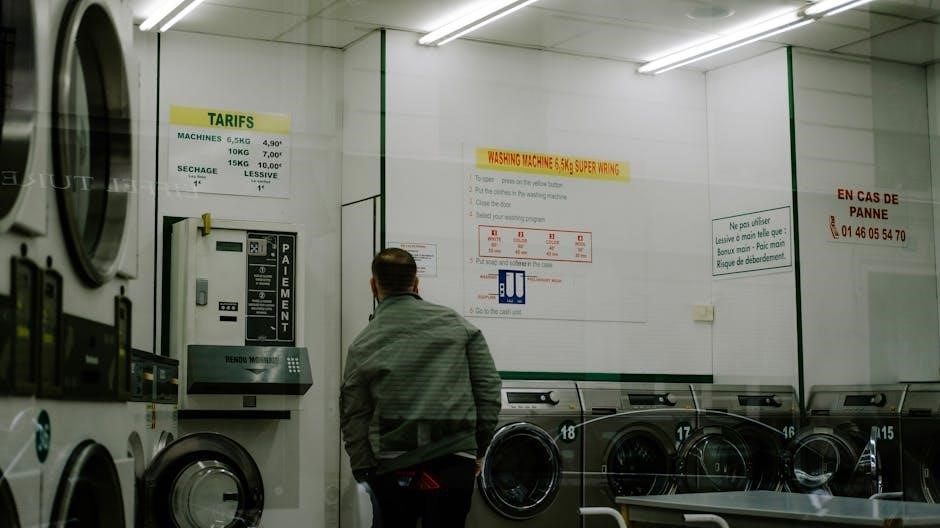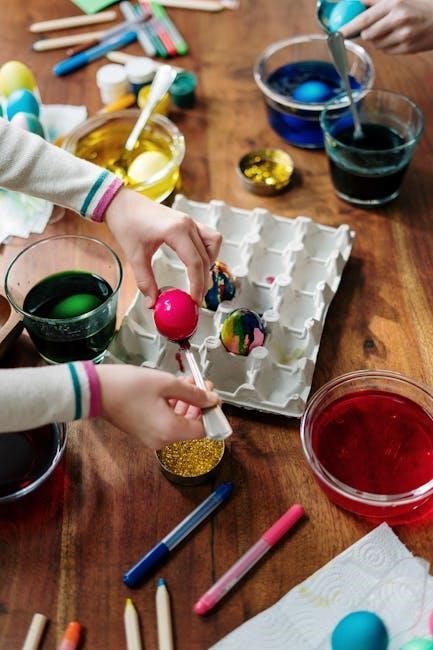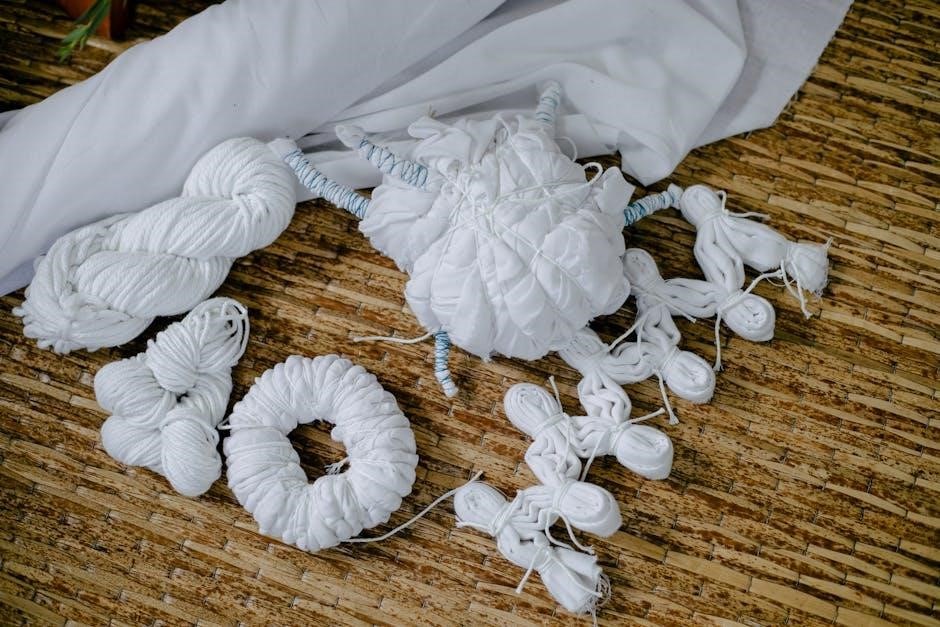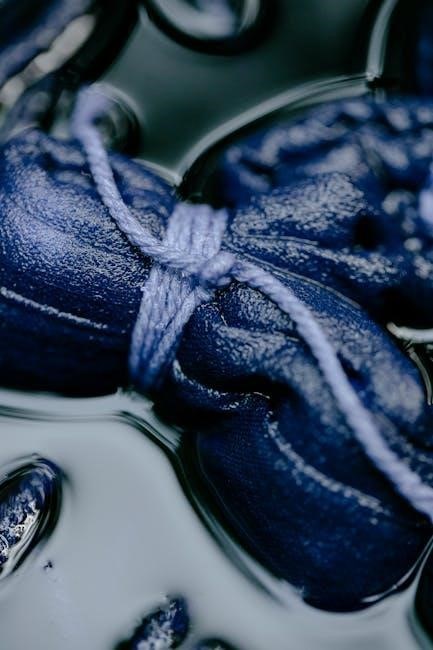
Ensure vibrant colors last by following Tulip tie-dye washing guidelines. Rinse thoroughly, wash in cold water with mild detergent, and avoid harsh chemicals for optimal results.
- Rinse gently before washing to remove excess dye.
- Use cold water to prevent color fading.
- Avoid fabric softeners and bleach to maintain brightness.
Understanding the Basics of Tulip Tie Dye
Tulip tie-dye works best on 100% cotton fabrics, with colors appearing darker before washing. Allow dye to set 6-8 hours, then rinse thoroughly for optimal results.
Importance of Proper Washing Techniques
Proper washing ensures vibrant, long-lasting colors. Improper techniques can cause fading or unevenness. Rinse thoroughly to remove excess dye, then wash in cold water with mild detergent to protect colors. Avoid hot water and harsh chemicals, as they can strip dye. Washing separately prevents color transfer. Following these steps maintains the integrity of your tie-dye design and keeps fabrics looking their best.
- Prevents color fading.
- Maintains fabric quality.
- Ensures vibrant results.
Materials Needed for Washing
Gather essential materials to protect your tie-dye creations. Use cold water, mild detergent without bleach or softeners, and a washing machine. For hand washing, a basin and gentle soap are ideal. Avoid harsh chemicals to preserve colors. Optional items include gloves for protection and a clean towel for drying. Proper materials ensure colors stay vibrant and fabrics remain intact.
- Cold water
- Mild detergent
- Gentle soap

Preparing for the Wash
Prepare your tie-dye item by rinsing thoroughly and checking for excess dye. Allow the dye to set for 6-8 hours before washing for optimal color retention.
- Rinse gently to remove loose dye.
- Check for excess dye before washing.
- Let the dye set for 6-8 hours.
Rinsing Before Washing
Rinsing is crucial before washing your tie-dye project. Start by gently rinsing under cold running water to remove excess dye. This step prevents dye from bleeding during the wash cycle. Use your hands to carefully agitate the fabric, ensuring all loose dye is removed. Continue rinsing until the water runs mostly clear. This process helps set the colors and ensures a vibrant finish. Avoid using hot water, as it can cause colors to fade prematurely. Proper rinsing sets the foundation for successful washing and long-lasting color retention.
Checking for Excess Dye
After rinsing, inspect the fabric for excess dye. If the water remains heavily colored, continue rinsing until it runs clear. Gently squeeze the fabric to check for residual dye. Excess dye can lead to color bleeding during washing. Pat the fabric dry with a clean towel to remove moisture. This step ensures minimal dye transfer and helps maintain vibrant colors. Properly checking for excess dye is essential for achieving professional-looking results and preventing fading in subsequent washes.

The Washing Process
Wash your tie-dye in cold water with a mild detergent to protect colors. Turn the garment inside out and wash separately to prevent dye transfer and fading.
First Wash: Setting the Dye
The first wash is crucial for setting the dye. Rinse the tie-dye gently under cold water to remove excess dye before washing. Turn the garment inside out and wash in cold water using a mild detergent without bleach or fabric softener. This prevents color fading and ensures vibrant results. Wash separately to avoid dye transfer. After washing, gently reshape the item and air dry to preserve colors. This process locks in the dye, ensuring long-lasting color vibrancy and maintaining the tie-dye design’s integrity.
Subsequent Washes: Maintaining Color
After the first wash, continue to maintain color vibrancy by washing in cold water with a mild, color-safe detergent. Avoid using bleach or fabric softeners, as they can strip the dye. Wash the tie-dye item inside out to protect the design. For best results, air dry instead of machine drying, as heat can cause fading. Over time, colors may soften slightly, but proper care ensures they remain vibrant. Regular cold-water washes and gentle handling will extend the life of your tie-dye creation.
Drying Your Tie Dye
Air drying is recommended to maintain color vibrancy. Machine drying can cause fading. Remove promptly and lay flat to dry, ensuring even drying and color preservation.
Air Drying vs. Machine Drying
Air drying is highly recommended for tie-dye fabrics to preserve color vibrancy and prevent fading. Machine drying can cause colors to bleed or fade due to heat exposure. For best results, remove dyed items from the washer promptly and lay them flat in a well-ventilated area. Avoid leaving wet dyed fabric on other surfaces, as it may transfer dye. Air drying ensures even evaporation and maintains the integrity of the design. This method is gentle and effective for long-lasting color retention.
- Air drying prevents color fading and bleeding.
- Machine drying can damage colors due to heat.
- Lay items flat to dry for even results.
Tips for Even Drying
For even drying, lay tie-dye items flat on a clean, dry surface or hang them upside down to prevent water spots. Avoid direct sunlight, as it may cause fading. Gently reshape the fabric to maintain its form while air drying. Ensure good airflow by placing items in a well-ventilated area. Do not overlap dyed fabrics, as this can lead to uneven drying and potential color transfer. Following these tips ensures your tie-dye designs remain vibrant and intact for years to come.
- Lay items flat or hang upside down to avoid water spots.
- Keep away from direct sunlight to prevent fading.
- Ensure good airflow for even drying.
Maintaining Color Vibrancy
Keep your Tulip tie-dye colors bright by using cold water and color-safe detergents. Avoid fabric softeners and bleach, as they can dull the hues over time.
- Cold water prevents dye from fading.
- Color-safe detergents protect vibrant colors.
- Avoid harsh chemicals like bleach.
Using Color-Safe Detergents
Using color-safe detergents is crucial for maintaining vibrant tie-dye colors. Avoid harsh chemicals like bleach or fabric softeners, as they can strip the dye from the fabric. Opt for mild, gentle detergents specifically designed for colored or hand-dyed items. These products are formulated to preserve color intensity and prevent fading. Always check the detergent label to ensure it suits your fabric type; By choosing the right detergent, you can enjoy your Tulip tie-dye creations for a longer time while keeping their colors fresh and bright.
Washing in Cold Water
Washing your Tulip tie-dye in cold water is essential for preserving the dye. Hot water can cause colors to fade quickly, while cold water helps lock the dye into the fabric. Use a gentle cycle with cold water to maintain color vibrancy. Avoid soaking dyed items in hot water, as this can weaken the dye bonds. For the first few washes, consider hand-washing in cold water for the best results. This method ensures your tie-dye remains bright and intact over time.

Special Care for Different Fabrics
Tulip tie-dye works best on 100% cotton fabrics, but blended materials require tailored care. Always avoid hot water and harsh detergents to protect the dye on any fabric type.
Cotton vs. Blends: Different Approaches
Tulip tie-dye works best on 100% cotton fabrics, as they absorb dye more effectively. Blends may result in less vibrant colors. For cotton, rinse thoroughly before washing and use cold water. Blends require gentler care to prevent fading. Avoid hot water and harsh detergents for both. Always wash dyed items separately, especially in the initial washes. This ensures color retention and prevents bleeding. Proper fabric-specific care extends the life of your tie-dye designs.
- Cotton: Ideal for bold, long-lasting colors.
- Blends: May fade faster, requiring extra caution.

Common Mistakes to Avoid
Avoid using hot water and harsh detergents, as they can fade colors. Not rinsing thoroughly before washing can lead to dye bleeding. Proper technique ensures longevity.
- Using hot water fades colors quickly.
- Not rinsing thoroughly causes dye bleeding.
- Harsh detergents strip away vibrant hues.
Using Hot Water
Using hot water when washing tie-dye fabrics can cause colors to fade rapidly. Hot water opens up fabric fibers, stripping away dye and diminishing vibrancy. While colors may appear darker when fabric is damp, hot water washes lead to premature fading. This is especially true for Tulip tie-dye, as the dyes are designed to set best in cold water. Avoid this common mistake to preserve the intensity of your design. Always opt for cold water to maintain the longevity and brightness of your tie-dye creations.
- Hot water strips dye from fibers.
- Cold water preserves color intensity.
- Initial damp color darkness is temporary.
Not Rinsing Thoroughly
Not rinsing thoroughly before washing can lead to excess dye bleeding during the wash cycle. This can cause colors to fade unevenly and may stain other fabrics. Proper rinsing ensures that loose dye is removed, preventing unwanted color transfer. For Tulip tie-dye, rinse until water runs clear to maintain vibrant colors. Skipping this step can result in dull, faded designs. Always rinse gently but thoroughly to protect your tie-dye creations.
- Excess dye can bleed during washing.
- Improper rinsing leads to color fading.
- Rinse until water is clear for best results.

Troubleshooting Color Fading
Color fading often results from using hot water or harsh detergents. To fix, re-dye or refresh colors with Tulip kits. Always rinse thoroughly and use cold water.
- Hot water accelerates dye fading.
- Harsh detergents strip color vibrancy.
- Re-dyeing can restore original brightness.
Why Colors Fade
Colors fade due to improper washing techniques, such as using hot water or harsh detergents. Hot water breaks down dye bonds, while harsh chemicals strip color vibrancy. Fabric softeners can also affect dye adhesion, leading to faster fading. Ensuring thorough rinsing before washing and using cold water with mild, color-safe detergents helps preserve colors. Allowing the dye to set fully before washing is crucial for long-lasting vibrancy.
Re-dyeing Options
If colors fade, re-dyeing is a viable option. Use Tulip tie-dye kits for consistent results. Wash and dry the fabric first to prepare it for new dye. Ensure the fabric is clean and dry before applying fresh dye. Follow the kit instructions carefully, allowing sufficient time for the dye to set. For best results, rinse thoroughly after re-dyeing and wash separately in cold water with a mild detergent. This process can restore vibrancy and extend the life of your tie-dye creation.
- Use Tulip kits for consistent color results.
- Ensure fabric is clean and dry before re-dyeing.
- Allow ample time for the dye to set properly.

Environmental Considerations
Dispose of dye water responsibly and use eco-friendly detergents to minimize environmental impact. Avoid harsh chemicals to protect waterways and prolong fabric life naturally.
Disposal of Dye Water
Properly dispose of dye water to protect the environment. Dilute dye water with excess cold water before disposal. Check local regulations for hazardous waste guidelines. Use eco-friendly detergents to minimize water contamination. Avoid pouring dye water directly into storm drains. Consider neutralizing dye water with vinegar before disposal. Always follow local environmental protocols for responsible waste management. Keep waterways clean and ensure sustainable practices when working with Tulip tie-dye products.
Eco-Friendly Detergents
Opt for eco-friendly detergents when washing Tulip tie-dye items to protect both colors and the environment. Choose biodegradable, phosphate-free options that are gentle on fabrics and waterways. These detergents are free from harsh chemicals, preserving dye vibrancy and reducing environmental impact. Look for certifications like EPA Safer Choice to ensure sustainability. Eco-friendly detergents maintain color brightness while being kinder to the planet, making them ideal for tie-dye care.
- Biodegradable and phosphate-free formulas.
- Gentle on fabrics and colors.
- EPA Safer Choice certification recommended.